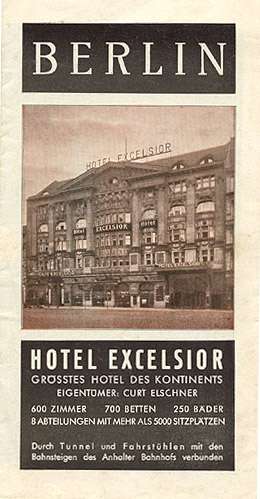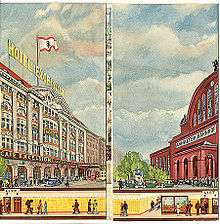Hotel Excelsior

Hotel Excelsior occupied number 112/113, Königgrätzer Straße (today’s Stresemannstrasse) on Askanischer Platz in the Berlin district of Kreuzberg. It was once one of the largest and most luxurious hotels in Europe but its destruction during World War II resigned it to the German capital's list of lost historical landmarks.
Early years
Otto Rehnig – the architect responsible for the similarly fated Hotel Esplanade Berlin – was commissioned to design a hotel to accommodate the floods of passengers arriving in at the Anhalter Bahnhof across the street. When the Excelsior first opened on 2 April 1908 after over two years of construction work it accommodated a modest 200 rooms but when an additional section was built on Anhalter Strasse 6 in 1912/13 the hotel had already almost doubled in size.
The untimely re-opening of the hotel on the eve of World War I meant that the building spent its early existence comparatively empty. As the war progressed the hotel’s fortunes dwindled. The saviour of the Excelsior appeared in 1919 in the form of Curt Elschner (1876–1963). In 1903 he took out a lease on the Hotel Metropol in Erfurt, before taking over the Hotel Esplanade in Hamburg and then a number of other hotels and restaurants across Germany. After his war service Elschner spent a short time in 1919 working as an advisor and frontman to the politician and industrialist Hugo Stinnes, when the latter was elected into parliament in Berlin, before Elschner finally took the reins of the Excelsior.
Excelsior expansion in the golden twenties
Under Elschner’s management the 1920s witnessed the Excelsior's transformation from a low-key and ailing enterprise into an extravagant, successful and modern 7,500 square metres (81,000 sq ft) hotel complex.
Using contemporary deluxe US hotels as inspiration, Elschner set about completely modernising and expanding his new property. New power and water systems and gas heating were established and the coal-powered bakery and kitchens were introduced to electricity. Between 1925 and 1926 the hotel's guest capacity was expanded under the guidance of architects Heidenreich und Michel. In 1927/28, under the direction of architect Johann Emil Schaudt (1871–1957), an 1800 m² area of the hotel cellars was transformed into a spa.

Arguably what established the Excelsior’s superior status beyond question was the 1929 construction of an underpass connecting the hotel with the Anhalter Bahnhof across the street. The 80-metre long, 3-metre wide and 3-metre high 1.2 million Reichmark construction, is believed to have been the largest of its type in the world. The tunnel meant that the hotel’s privileged guests could travel from their train compartment to their hotel bedroom and back again without ever having to step out into the chaotic bustle of Askanischen Platz. An official railway ticket booth in the hotel meant that they did not even need to bother queuing up at the station either.
When the dramatic renovation was complete the Hotel Excelsior accommodated 600 rooms, 750 beds, 250 bathrooms, 9 restaurants, a library, as well as such everyday amenities as a tailors, cobblers, butchers and bakers. It also provided guests with a choice of 200 daily newspapers from around the world. The interior decoration was equally lavish with marble covered walls and adornment by the Berlin-born artist Carl Langhammer (1868–1956).
The Excelsior may not have been as distinguished as Berlin’s Adlon, Kaiserhof or Esplanade but it was the largest, and at the end of the twenties it firmly established itself as the largest not only in Berlin, but across the whole continent.
Excelsior in Hitler’s thirties
At the start of the 1930s NSDAP leadership in Munich earmarked the Excelsior as Hitler’s base in Berlin until he secured leadership. The proposal was rejected by Elschner however and the Führer was forced to opt for the Hotel Kaiserhof in Wilhelmplatz. The NSDAP did not take the snub with good grace and promptly imposed a party ban on the hotel. Nevertheless, this did not stop them sparking further controversy within its walls. Its grand hall, known as "Saal des freien Denkens" (The Hall of Free Thought), featured numerous stain-glass windows featuring popes, religious founders and various Greek and Jewish philosophers. The NSDAP objected to the images of Jews and after a violent debate they were packed away in crates and replaced by portraits of the new leadership. They also objected to many of the titles in the hotel library and so these were taken away and burnt.
World War II and the demise of the Excelsior
At the beginning of World War II, Elschner fled Germany and in 1942 the NSV (Nationalsozialistische Volkswohlfahrt), a welfare subsidiary of the NSDAP, took over ownership of the Excelsior. It was during the wartime period that the hotel became known as the "Fehling-Bunker". The title honoured Jürgen Fehling, the then director at the theatre in Königgrätzer Straße (today known as the Hebbel Theater). A sign hung over the main entrance saying “Wehrmacht-Betreuungsstelle (Armed-Forces Care Point) Gepäckaufbewahrung (Left Luggage)”.
At the end of April 1945, as the war was coming to an end, Allied bombers reduced the Excelsior to a burning ruin. The attack left many dead and the hotel largely destroyed. Any riches that survived the assault were swiftly plundered. In 1954 it was demolished completely, six years before the remains of the Anhalter Bahnhof were pulled down. Whether or not the underpass that connected them still exists is unclear.
Aftermath

Between 1967 and 1972 the architect group G. Krebs and Sobotka & Müller erected a building with 500 apartments, shops and business offices on the hotel site for the "Excelsior-Petrol Station GmbH & Co KG".
A hotel with the traditional name "Hotel Excelsior" is located today in the Hardenbergstraße in the Berlin district of Charlottenburg-Wilmersdorf and is managed by the hotel management company "Grand City Hotels & Resort".
Legacy
The Excelsior was the inspiration for the novel Menschen im Hotel (1929) by the Austrian writer Vicki Baum (1888–1960). The book in turn inspired the Academy Award winning Hollywood film, Grand Hotel. The hotel appears in Walter Ruttmann's 1927 film Berlin: Symphony of a Metropolis.
It is believed that it was here, on the 11 November 1918, that Karl Liebknecht and Rosa Luxemburg’s leftist revolutionary group renamed themselves the Spartakusbund (The Spartacus League).
Coordinates: 52°30′16″N 13°22′59″E / 52.50444°N 13.38306°E